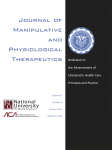
Effect of HVLA vs. sham on vertical jump in athletes with talocrural joint dysfunction

Effect of HVLA vs. sham on vertical jump in athletes with talocrural joint dysfunction
Effect of chiropractic manipulation on vertical jump height in young female athletes with talocrural joint dysfunction: a single-blind randomized clinical pilot trial
J Manipulative Physiol Ther. 2014 Feb;37(2):116-23. doi: 10.1016/j.jmpt.2013.11.004. Epub 2014 Jan 2Synopsis
22 female elite-level handball athletes with talocrural joint dysfunction were randomized to undergo high-velocity, low-amplitude (HVLA) manipulation to either the talocrural joint (active treatment) or the distal tibia (sham treatment). The purpose of this pilot study was to determine the feasibility of trial comparing these two interventions with respect to improvements in vertical jump height. ...
To view the full content, login to your account,
or start your 30-day FREE Trial today.
FREE TRIAL
LOGIN
Forgot Password?
Explore some of our unlocked ACE Reports below!

Learn about our AI Driven
High Impact Search Feature
Our AI driven High Impact metric calculates the impact an article will have by considering both the publishing journal and the content of the article itself. Built using the latest advances in natural language processing, OE High Impact predicts an article’s future number of citations better than impact factor alone.
Continue



 LOGIN
LOGIN

Join the Conversation
Please Login or Join to leave comments.